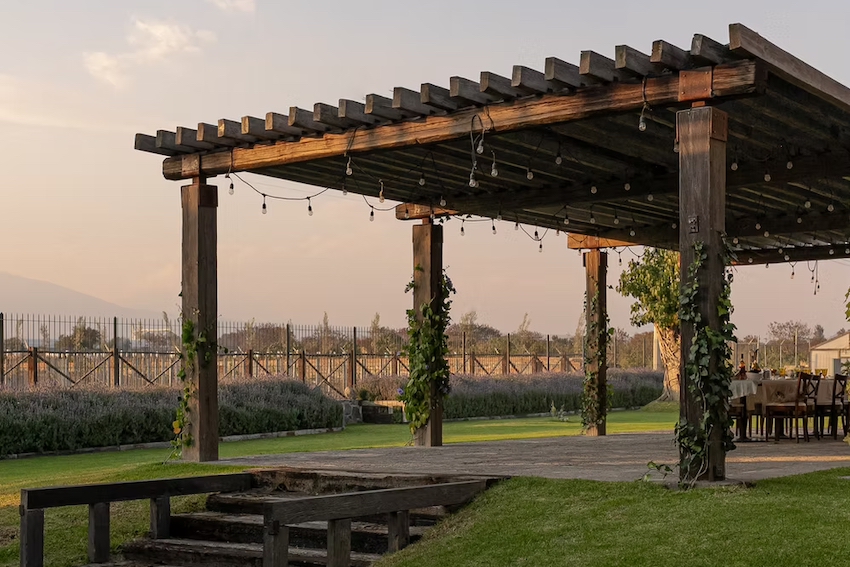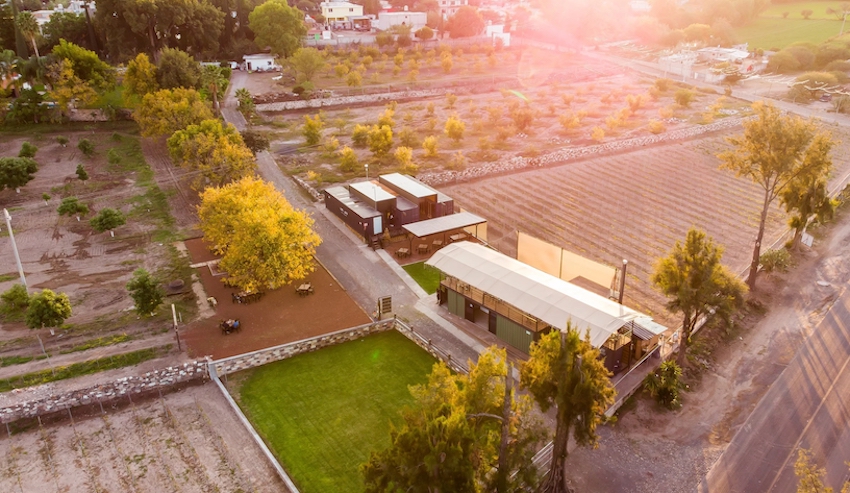While it might seem unlikely, the central states of Puebla and Hidalgo have been on the map of Mexican wine-producing states for several years. Puebla began producing wine around 17 years ago and though this may seem relatively recent, records from New Spain indicate that this area once produced high-quality grapes and wheat during the Colonial period, eventually suffering from the royal edicts that prohibited wine in the 17th and 18th centuries.
Today, the state has three wineries that stand out, with a future outlook predicting many more in the coming years, as the once notable area looks to reestablish its one great vineyards.
Bodega Entreerres
Bodega Entreerres is located in Calpa, Puebla, a town famous for its part in the creation of chile en nogada, a dish prepared for General Agustin Iturbide during Mexican Independence and now one of the country’s most famous recipes.
It is surrounded by beautiful landscapes, with the Popocatépetl and Iztaccíhuatl volcanoes in the distance. Getting to the winery takes about 30 minutes from the city of Puebla. There is an on site restaurant and eight different wine varietals that you can taste after a walk through the vineyards.
Their white wine production stands out, particularly the Sauvignon Blanc. Interestingly, however, Entreerres offers a red wine made with Pinot Noir. While Pinot Noir is famously difficult to cultivate, it has taken very well to the soils of Puebla, producing a delicious blend that is well worth trying. The must-try bottle is NTC 2021, which has won national awards. Another, S1, is an equally well-made Syrah wine that expresses the character of this powerful grape variety grown in volcanic soil.
Visits are available on weekends by reservation only.
Santo Domingo

Atlixco is one of the best-known towns in Puebla, located at the foot of the region’s volcanoes. It is a magical town famous for its flower production, as well as its high-quality mezcal.
A few years ago, the Santo Domingo Vineyard in Atlixco opened its doors to the wine tourism scene. The project began in 2008, with vines imported from France and across the Americas. The plants here are nourished by the uniquely rich volcanic soil at the base of Popocatépetl and Iztaccíhuatl volcanoes, considered to have special properties.
Here, the rosé wines made from Malbec grapes stand out. There is a sparkling and a still wine, both called “Ceniza” (Ash), bin tribute to Santo Domingo’s proximity to the volcanoes and the characteristics that this type of soil provides.
The vineyard’s rosé wines are ideal for Puebla’s most famous dishes, its moles and chiles en nogada and cemitas.
Visits are by reservation only and require a minimum of ten people.
Casa Miguel Henández
Miguel Hernandez is a Mexican oenologist who studied in France and Chile and is an expert in vineyard development. He has had a distinguished career, studying in Europe and South America and working with major wineries and projects in those regions. He has even been a jury member at the Chasselas World Competition in Switzerland. In 2011, he decided to return to his roots, launching his own project in Cholula, Puebla, hoping to promote wine culture in his home state.
Today, his vineyards can be found in 14 locations throughout the state, providing employment to more than 32 families dedicated to growing grapes and producing wine. Make sure to try his Pinot Noir if you stop by.
Tierra y Almas

In the neighbouring state of Hidalgo, specifically, the town of Tecozautla, lies the Tierra y Almas vineyard. Nestled in a magic town of its own, the wine and nature together hand in hand.
Here, you can enjoy a grand reserve made with Cabernet Sauvignon, a powerful Malbec, and a well-balanced rosé blend of Syrah and Malbec, which is fresh but powerful enough to accompany mature cheeses.
Tierra y Alma also produces sparkling wine made from the Xarel-lo and Macabeo grape varieties, in the style of Cava. There is an on site museum which provides additional information to enhance the overall experience. It has rooms for rent, a thermal pool, gardens, and green spaces with views from the terraces of the rooms.
As one of the closest wineries to Mexico City, it makes for a perfect weekend getaway when you’re tired of the big city bustle.
Mexican Wine Day
October 7 is Mexican Wine Day, a date that has been celebrated since 2023 and has served to promote production, consumption, and awareness of the national wine industry. In recent years, the importance of domestic production has grown, more producers have joined the industry, quality has improved, and the variety of labels has increased each year.
Diana Serratos studied at Universidad Nacional Autónoma de México (UNAM) and UNCUYO in Mendoza, Argentina, where she lived for over 15 years. She specializes in wines and beverages, teaching aspiring sommeliers at several universities. She conducts courses, tastings and specialized training.
